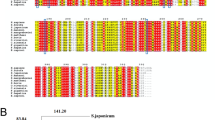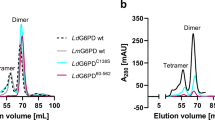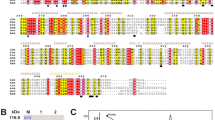Abstract
Fasciola gigantica is an important food-borne trematode responsible for the hepatobiliary disease, commonly known as fascioliasis. In F. gigantica, the glyceraldehyde 3-phosphate dehydrogenase (FgGAPDH) is a key enzyme of the glycolytic pathway and catalyzes the reversible oxidative phosphorylation of d-glyceraldehyde-3-phosphate (G-3-P) to 1,3-bisphosphoglycerate (1,3-BPG), with the simultaneous reduction of NAD+ to NADH. In the present study, we analyzed the sequence of FgGAPDH and investigated its structural, binding, and catalytic properties. Sequence alignment of FgGAPDH showed 100% identity with the sister fluke Fasciola hepatica GAPDH. The gapdh gene was cloned and expressed in Escherichia coli, and the recombinant protein was purified. The purified FgGAPDH exists as a homo-tetramer, composed of a ~ 37-kDa subunit under non-dissociating conditions at 300 mM salt concentration indicating that higher salt stabilizes the tetrameric state. The binding of the cofactor NAD+ caused a conformational rearrangement in the enzyme structure, leading to the stabilization of the enzyme. A homology model of FgGAPDH was constructed, the cofactor (NAD+) and substrate (G-3-P) were docked, and the binding sites were identified in a single chain. The inter-subunit cleft of GAPDH that has been exploited for structure-based drug design in certain protozoan parasites is closed in the case of FgGAPDH, similar to the human GAPDH. Thus, the conformation of FgGAPDH in this region is similar to the human enzyme. Therefore, GAPDH may not be a suitable target for drug discovery against fascioliasis. Still, the analysis of the structural and functional attributes of GAPDH will be significant in understanding the various roles of this enzyme in the parasite as well as provide new insights into the biochemistry of flukes.








Similar content being viewed by others
Abbreviations
- GAPDH:
-
Glyceraldehyde 3-phosphate dehydrogenase
- FgGAPDH:
-
F. gigantica glyceraldehyde 3-phosphate dehydrogenase
- SEC:
-
Size exclusion chromatography
- G-3-P:
-
d-glyceraldehyde-3-phosphate
- DTT:
-
Dithiothreitol
- HEPES:
-
(4-(2-Hydroxyethyl)-1-piperazineethanesulfonic acid)
References
Anderson N, Luong TT, Vo NG, Bui KL, Smooker PM, Spithill TW (1999) The sensitivity and specificity of two methods for detecting Fasciola infections in cattle. Vet Parasitol 83(1):15–24
Aronov AM, Suresh S, Buckner FS, van Voorhis WC, Verlinde CLMJ, Opperdoes FR, Hol WGJ, Gelb MH (1999) Structure-based design of submicromolar, biologically active inhibitors of trypanosomatid glyceraldehyde-3-phosphate dehydrogenase. Proc Natl Acad Sci U S A 96(8):4273–4278
Ashmarina LI, Muronetz VI, Nagradova NK (1981) Immobilized D-glyceraldehyde-3-phosphate dehydrogenase can exist as a trimer. FEBS Lett 128(1):22–26
Baker BY, Shi W, Wang B, Palczewski K (2014) High-resolution crystal structures of the photoreceptor glyceraldehyde 3-phosphate dehydrogenase (GAPDH) with three and four-bound NAD molecules. Protein Sci 23(11):1629–1639
Baxi MD, Vishwanatha JK (1995) Uracil DNA-glycosylase/glyceraldehyde-3-phosphate dehydrogenase is an Ap4A binding protein. Biochemistry 34(30):9700–9707
Bero J, Beaufay C, Hannaert V, Herent MF, Michels PA, Quetin-Leclercq J (2013) Antitrypanosomal compounds from the essential oil and extracts of Keetia leucantha leaves with inhibitor activity on Trypanosoma brucei glyceraldehyde-3-phosphate dehydrogenase. Phytomedicine 20(3–4):270–274. https://doi.org/10.1016/j.phymed.2012.10.010
Biu AA, Ahmed MI, Mshelia SS (2006) Economic assessment of losses due to parasitic diseases common at the Maiduguri abattoir, Nigeria. vol 7, p 143–145
Bowie JU, Luthy R, Eisenberg D (1991) A method to identify protein sequences that fold into a known three-dimensional structure. Science 253(5016):164–170
Carlile GW, Chalmers-Redman RM, Tatton NA, Pong A, Borden KE, Tatton WG (2000) Reduced apoptosis after nerve growth factor and serum withdrawal: conversion of tetrameric glyceraldehyde-3-phosphate dehydrogenase to a dimer. Mol Pharmacol 57(1):2–12
Chenna R, Sugawara H, Koike T, Lopez R, Gibson TJ, Higgins DG, Thompson JD (2003) Multiple sequence alignment with the Clustal series of programs. Nucleic Acids Res 31(13):3497–3500
Colovos C, Yeates TO (1993) Verification of protein structures: patterns of nonbonded atomic interactions. Protein Sci 2(9):1511–1519
Cywinska A (2005) Epidemiology of fascioliasis in human endemic areas. J Helminthol 79(3):207–216
Dell'Antone P (2009) Targets of 3-bromopyruvate, a new, energy depleting, anticancer agent. Med Chem 5(6):491–496
Elshraway NT, Mahmoud WG (2017) Prevalence of fascioliasis (liver flukes) infection in cattle and buffaloes slaughtered at the municipal abattoir of El-Kharga, Egypt. Vet World 10(8):914–917. https://doi.org/10.14202/vetworld.2017.914-91
Ferreira-da-Silva F, Pereira PJB, Gales L, Roessle M, Svergun DI, Moradas-Ferreira P, Damas AM (2006) The crystal and solution structures of glyceraldehyde-3-phosphate dehydrogenase reveal different quaternary structures. J Biol Chem 281(44):33433–33440
Fothergill-Gilmore LA, Michels PA (1993) Evolution of glycolysis. Prog Biophys Mol Biol 59(2):105–235
France RM, Grossman SH (2000) Acrylamide quenching of apo- and holo-alpha-lactalbumin in guanidine hydrochloride. Biochem Biophys Res Commun 269(0006-291X (Print)):709–712
Frayne J, Taylor A, Cameron G, Hadfield AT (2009) Structure of insoluble rat sperm glyceraldehyde-3-phosphate dehydrogenase (GAPDH) via heterotetramer formation with Escherichia coli GAPDH reveals target for contraceptive design. J Biol Chem 284(34):22703–22712
Ganapathy-Kanniappan S et al (2009) Glyceraldehyde-3-phosphate dehydrogenase (GAPDH) is pyruvylated during 3-bromopyruvate mediated cancer cell death. Anticancer Res 29(12):4909–4918
Ganapathy-Kanniappan S, Kunjithapatham R, Geschwind JF (2013) Anticancer efficacy of the metabolic blocker 3-bromopyruvate: specific molecular targeting. Anticancer Res 33(1):13–20
Goodsell DS, Morris GM, Olson AJ (1996) Automated docking of flexible ligands: applications of AutoDock. J Mol Recognit 9(1):1–5
Harris JI, Waters M (1976) 1 Glyceraldehyde-3-phosphate dehydrogenase. Enzymes 13:1–49
Hoagland VD Jr, Teller DC (1969) Influence of substrates on the dissociation of rabbit muscle D-glyceraldehyde 3-phosphate dehydrogenase. Biochemistry 8(2):594–602
Jenkins JL, Tanner JJ (2006) High-resolution structure of human D-glyceraldehyde-3-phosphate dehydrogenase. Acta Crystallogr D Biol Crystallogr 62(Pt 3):290–301
Krebs EG (1955) Glyceraldehyde-3-phosphate dehydrogenase from yeast. Methods Enzymol 1:407–411
Lakatos S, Zavodsky P (1976) The effect of substrates on the association equilibrium of mammalian D-glyceraldehyde 3-phosphate dehydrogenase. FEBS Lett 63(1):145–148
Laskowski RA, Hutchinson EG, Michie AD, Wallace AC, Jones ML, Thornton JM (1997) PDBsum: a web-based database of summaries and analyses of all PDB structures. Trends Biochem Sci 22(12):488–490
Luthy R, Bowie JU, Eisenberg D (1992) Assessment of protein models with three-dimensional profiles. Nature 356(6364):83–85. https://doi.org/10.1038/356083a0
Mas-Coma S, Funatsu IR, Bargues MD (2001) Fasciola hepatica and lymnaeid snails occurring at very high altitude in South America. Parasitology 123(Suppl):S115–S127
Mazzola JL, Sirover MA (2001) Reduction of glyceraldehyde-3-phosphate dehydrogenase activity in Alzheimer’s disease and in Huntington’s disease fibroblasts. J Neurochem 76(2):442–449
Möller M, Denicola A (2002) Protein tryptophan accessibility studied by fluorescence quenching. Biochem Mol Biol Educ 30(3):175–178. https://doi.org/10.1002/bmb.2002.494030030035
Nelson D, Goldstein JM, Boatright K, Harty DWS, Cook SL, Hickman PJ, Potempa J, Travis J, Mayo JA (2001) pH-regulated secretion of a glyceraldehyde-3-phosphate dehydrogenase from Streptococcus gordonii FSS2: purification, characterization, and cloning of the gene encoding this enzyme. J Dent Res 80(1):371–377
Osborne HH, Hollaway MR (1976) An investigation of the nicotinamide-adenine dinucleotide-induced ‘tightening’ of the structure of glyceraldehyde 3-phosphate dehydrogenase. Biochem J 157(1):255–259
Pathak RK, Baunthiyal M, Shukla R, Pandey D, Taj G, Kumar A (2017) In silico identification of mimicking molecules as defense inducers triggering jasmonic acid mediated immunity against Alternaria blight disease in Brassica species. Front Plant Sci 8:609. https://doi.org/10.3389/fpls.2017.00609
Pawlowski M, Gajda MJ, Matlak R, Bujnicki JM (2008) MetaMQAP: a meta-server for the quality assessment of protein models. BMC Bioinformatics 9:403. https://doi.org/10.1186/1471-2105-9-403
Pettersen EF, Goddard TD, Huang CC, Couch GS, Greenblatt DM, Meng EC, Ferrin TE (2004) UCSF Chimera—a visualization system for exploratory research and analysis. J Comput Chem 25(13):1605–1612
Robert X, Gouet P (2014) Deciphering key features in protein structures with the new ENDscript server. Nucleic Acids Res 42(Web Server issue):W320–W324. https://doi.org/10.1093/nar/gku316
Saunders PA, Chen RW, Chuang DM (1999) Nuclear translocation of glyceraldehyde-3-phosphate dehydrogenase isoforms during neuronal apoptosis. J Neurochem 72(3):925–932
Schultz DE, Hardin CC, Lemon SM (1996) Specific interaction of glyceraldehyde 3-phosphate dehydrogenase with the 5′-nontranslated RNA of hepatitis A virus. J Biol Chem 271(24):14134–14142
Shukla H, Shukla R, Sonkar A, Pandey T, Tripathi T (2017a) Distant Phe345 mutation compromises the stability and activity of Mycobacterium tuberculosis isocitrate lyase by modulating its structural flexibility. Sci Rep 7(1):1058. https://doi.org/10.1038/s41598-017-01235-z
Shukla H, Shukla R, Sonkar A, Tripathi T (2017b) Alterations in conformational topology and interaction dynamics caused by L418A mutation leads to activity loss of Mycobacterium tuberculosis isocitrate lyase. Biochem Biophys Res Commun 490:276–282. https://doi.org/10.1016/j.bbrc.2017.06.036
Shukla R, Shukla H, Tripathi T (2018) Activity loss by H46A mutation in Mycobacterium tuberculosis isocitrate lyase is due to decrease in structural plasticity and collective motions of the active site. Tuberculosis (Edinb) 108:143–150
Singh R, Green MR (1993) Sequence-specific binding of transfer RNA by glyceraldehyde-3-phosphate dehydrogenase. Science 259(5093):365–368
Sirover MA (1999) New insights into an old protein: the functional diversity of mammalian glyceraldehyde-3-phosphate dehydrogenase. Biochim Biophys Acta 1432(2):159–184
Soares FA, Sesti-Costa R, da Silva JS, de Souza MCBV, Ferreira VF, da C. Santos F, Monteiro PAU, Leitão A, Montanari CA (2013) Molecular design, synthesis and biological evaluation of 1,4-dihydro-4-oxoquinoline ribonucleosides as TcGAPDH inhibitors with trypanocidal activity. Bioorg Med Chem Lett 23(16):4597–4601. https://doi.org/10.1016/j.bmcl.2013.06.029
Van de Weert M, Stella L (2011) Fluorescence quenching and ligand binding: a critical discussion of a popular methodology. J Mol Struct 998(1–3):144–150. https://doi.org/10.1016/j.molstruc.2011.05.023
Webb B, Sali A (2014) Comparative protein structure modeling using MODELLER. Curr Protoc Bioinformatics 47:5 6 1–5 632. https://doi.org/10.1002/0471250953.bi0506s47
WHO (2015) WHO estimates of the global burden of foodborne diseases: foodborne disease burden epidemiology reference group 2007–2015. World Health Organization
Wiederstein M, Sippl MJ (2007) ProSA-web: interactive web service for the recognition of errors in three-dimensional structures of proteins. Nucleic Acids Res 35(Web Server):W407–W410. https://doi.org/10.1093/nar/gkm290
Zinsser VL, Hoey EM, Trudgett A, Timson DJ (2014) Biochemical characterisation of glyceraldehyde 3-phosphate dehydrogenase (GAPDH) from the liver fluke, Fasciola hepatica. Biochim Biophys Acta 1844(4):744–749. https://doi.org/10.1016/j.bbapap.2014.02.008
Author information
Authors and Affiliations
Contributions
PBC and RS carried out all the experiments. PBC, RS, and TT analyzed the data, conceived the study, and participated in its design and coordination and drafted the manuscript. All authors read and approved the final manuscript.
Corresponding author
Ethics declarations
Competing interests
The authors declare that there are no competing interests.
Additional information
Section Editor: Xing-Quan Zhu
Publisher’s Note
Springer Nature remains neutral with regard to jurisdictional claims in published maps and institutional affiliations.
Electronic supplementary material
ESM 1
(DOCX 2028 kb)
Rights and permissions
About this article
Cite this article
Chetri, P.B., Shukla, R. & Tripathi, T. Identification and characterization of glyceraldehyde 3-phosphate dehydrogenase from Fasciola gigantica. Parasitol Res 118, 861–872 (2019). https://doi.org/10.1007/s00436-019-06225-w
Received:
Accepted:
Published:
Issue Date:
DOI: https://doi.org/10.1007/s00436-019-06225-w




